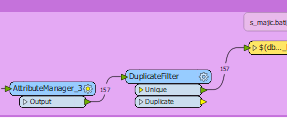Looking at the specific error message in the log, which reads:
ORA-00001: violation de contrainte unique (C##S_MAJIC.BATI_40_DESCR_HAB_PK)
We can tell that it's the unique constraint named "BATI_40_DESCR_HAB_PK" that's raising the error. You could use a tool like SQLDeveloper or TOAD etc. to look at the definition of this particular constraint, which should give you the information you need to find a workaround in your workspace.
My hunch, based on the name of the constraint, is that this is probably the primary key constraint. A starting point could therefore be to check which value you're setting for the primary key column(s) in FME and to make sure that this value doesn't already exist in the table you're writing to.






